POLICY AND PRACTICE
Burden of major musculoskeletal conditions
Charge de morbidité liée aux affections majeures du système ostéo-articulaire
Carga de trastornos musculoesqueléticos importantes
Anthony D. WoolfI,1; Bruce PflegerII
IProfessor of Rheumatology, Peninsula Medical School, Duke of Cornwall Department of Rheumatology, Royal Cornwall Hospital, Truro TR1 3 L J, England (email: woolfa@dialin.net)
IIManagement of Noncommunicable Diseases, World Health Organization, Geneva, Switzerland
ABSTRACT
Musculoskeletal conditions are a major burden on individuals, health systems, and social care systems, with indirect costs being predominant. This burden has been recognized by the United Nations and WHO, by endorsing the Bone and Joint Decade 20002010. This paper describes the burden of four major musculoskeletal conditions: osteoarthritis, rheumatoid arthritis, osteoporosis, and low back pain. Osteoarthritis, which is characterized by loss of joint cartilage that leads to pain and loss of function primarily in the knees and hips, affects 9.6% of men and 18% of women aged >60 years. Increases in life expectancy and ageing populations are expected to make osteoarthritis the fourth leading cause of disability by the year 2020. Joint replacement surgery, where available, provides effective relief. Rheumatoid arthritis is an inflammatory condition that usually affects multiple joints. It affects 0.31.0% of the general population and is more prevalent among women and in developed countries. Persistent inflammation leads to joint destruction, but the disease can be controlled with drugs. The incidence may be on the decline, but the increase in the number of older people in some regions makes it difficult to estimate future prevalence. Osteoporosis, which is characterized by low bone mass and microarchitectural deterioration, is a major risk factor for fractures of the hip, vertebrae, and distal forearm. Hip fracture is the most detrimental fracture, being associated with 20% mortality and 50% permanent loss in function. Low back pain is the most prevalent of musculoskeletal conditions; it affects nearly everyone at some point in time and about 433% of the population at any given point. Cultural factors greatly influence the prevalence and prognosis of low back pain.
Keywords: Musculoskeletal diseases/epidemiology/complications; Osteoarthritis/epidemiology/complications; Arthritis Rheumatoid/ epidemiology/complications; Osteoporosis/epidemiology/complications; Fractures/epidemiology; Low back pain/epidemiology/ complications; Cost of illness; Risk factors (source: MeSH, NLM).
RÉSUMÉ
Les affections ostéo-articulaires représentent une lourde charge pour les individus, les systèmes de santé et les systèmes de sécurité sociale, compte tenu surtout des coûts indirects qui sensuivent. L'Organisation des Nations Unies et lOMS, reconnaissant limportance de ces affections, ont apporté leur soutien à la Décennie de l'os et de l'articulation. Le présent article décrit le fardeau que représentent quatre affections majeures du système ostéo-articulaire : larthrose, la polyarthrite rhumatoïde, lostéoporose et la lombalgie. Larthrose, qui est caractérisée par une détérioration des cartilages articulaires, responsable de douleurs et de perte fonctionnelle essentiellement au niveau du genou et de la hanche, touche 9,6 % des hommes et 18 % des femmes de plus de 60 ans. Laugmentation de lespérance de vie et le vieillissement des populations devraient porter larthrose au quatrième rang des causes d'incapacité dici à 2020. La chirurgie de remplacement, lorsquelle est disponible, entraîne un soulagement réel. La polyarthrite rhumatoïde est un état inflammatoire qui affecte généralement plusieurs articulations. Elle concerne entre 0,3 et 1,0 % de la population générale et touche plus particulièrement les femmes, dans les pays développés. Linflammation chronique conduit à la destruction de larticulation mais lévolution de la maladie peut être enrayée par des médicaments. Si lincidence est en baisse, laugmentation du nombre des personnes âgées dans certaines régions ne facilite pas lévaluation de la prévalence future de cette affection. Lostéoporose, qui se caractérise par une diminution de la masse osseuse et une détérioration de la microarchitecture du tissu osseux, constitue un facteur de risque majeur de fracture de la hanche, des vertèbres et de la partie distale de l'avant-bras. La fracture de la hanche est la plus préjudiciable car elle est associée à une mortalité de 20 % et à une perte fonctionnelle irréversible de 50 %. La lombalgie est l'affection ostéo-articulaire la plus courante ; elle concerne presque tout le monde à un moment quelconque de la vie et de 4 à 33 % environ de la population à un moment donné. La prévalence et le pronostic de la lombalgie dépendent étroitement de facteurs culturels.
Mots clés: Appareil locomoteur, Maladies/épidémiologie/complication; Arthrose/epidemiology/complications; Polyarthrite rhumatoïde/epidemiology/complications; Ostéoporose/epidemiology/complications; Fracture/epidemiology; Lombalgie/epidemiology/ complications; Coût maladie; Facteur risque (source: MeSH, INSERM).
RESUMEN
Las trastornos musculoesqueléticos constituyen una pesada carga para los individuos, los sistemas de salud y los sistemas de asistencia social, y entre sus consecuencias predominan los costos indirectos. Esta carga ha sido reconocida por las Naciones Unidas y la OMS, con el respaldo del Decenio de los Huesos y las Articulaciones. En el presente artículo se describe la carga correspondiente a cuatro trastornos musculoesqueléticos importantes: la osteoartritis, la artritis reumatoide, la osteoporosis y la lumbalgia. La osteoartritis, que se caracteriza por una pérdida de cartílago articular que provoca dolor y pérdida funcional a nivel sobre todo de las rodillas y las caderas, afecta a un 9,6% de los hombres y un 18% de las mujeres > 60 años. Se prevé que el aumento de la esperanza de vida y el envejecimiento de la población harán de la osteoartritis la cuarta causa de discapacidad en el año 2020. La cirugía de reemplazo articular, cuando es viable, proporciona un alivio eficaz. La artritis reumatoide es un trastorno inflamatorio que afecta generalmente a varias articulaciones. La sufre un 0,31,0% de la población general, y es más frecuente entre las mujeres y en los países desarrollados. La inflamación persistente conduce a la destrucción de la articulación, pero la enfermedad puede controlarse con medicamentos. Parece que la incidencia está disminuyendo, pero el aumento del número de personas mayores en algunas regiones hace difícil estimar cuál será la prevalencia en el futuro. La osteoporosis, que se caracteriza por una baja masa ósea y por el deterioro de la microarquitectura ósea, es un importante factor de riesgo de fracturas de la cadera, la columna y la parte distal del antebrazo. La fractura de cadera es la más grave, pues se asocia a una mortalidad del 20% y a una pérdida funcional permanente en el 50% de los casos. La lumbalgia es el trastorno musculoesquelético más frecuente; afecta a casi todo el mundo en algún momento de la vida, y aproximadamente al 433% de la población en un momento dado. Los factores culturales influyen enormemente en la prevalencia y el pronóstico de lumbalgia.
Palabras clave: Enfermedades musculoesqueléticas/epidemiología/complicaciones; Osteoartritis/epidemiología/complicaciones; Artritis reumatoidea/epidemiología/complicaciones; Osteoporosis/epidemiología/complicaciones; Fracturas/epidemiología; Dolor de la región lumbar/epidemiología/complicaciones; Costo de la enfermedad; Factores de riesgo (fuente: DeCS, BIREME).
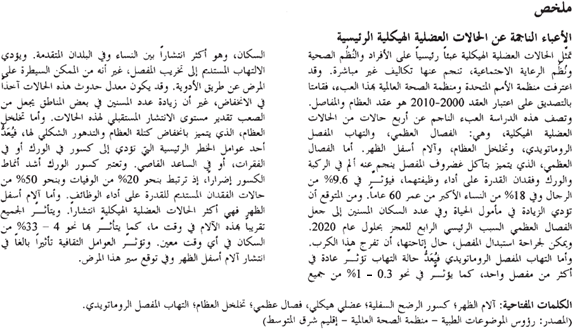
Introduction
Musculoskeletal conditions are prevalent and their impact is pervasive. They are the most common cause of severe long-term pain and physical disability, and they affect hundreds of millions of people around the world. They significantly affect the psychosocial status of affected people as well as their families and carers (1). At any one time, 30% of American adults are affected by joint pain, swelling, or limitation of movement (2). Musculoskeletal conditions are a diverse group with regard to pathophysiology but are linked anatomically and by their association with pain and impaired physical function. They encompass a spectrum of conditions, from those of acute onset and short duration to lifelong disorders, including osteoarthritis, rheumatoid arthritis, osteoporosis, and low back pain. The prevalence of many of these conditions increases markedly with age, and many are affected by lifestyle factors, such as obesity and lack of physical activity. The increasing number of older people and the changes in lifestyle throughout the world mean that the burden on people and society will increase dramatically. This has been recognized by the United Nations and WHO, with their endorsement of Bone and Joint Decade 20002010 (3).
The burden of musculoskeletal disorders can be measured in terms of the problems associated with them, that is the pain or impaired functioning (disability) related to the musculoskeletal system, or in relation to the cause, such as joint disease or trauma. The burden should also be considered in terms of who is at risk.
A review of existing data as part of the Bone and Joint Monitor Project in collaboration with WHOs global burden of disease 2000 project recently identified the burden of musculoskeletal conditions (4).
Pain and disability associated with the musculoskeletal system
Pain is the most prominent symptom in most people with arthritis (5), and is the most important determinant of disability in patients with osteoarthritis (6). Self-reported persistent pain related to the musculoskeletal system has been used in a number of population-based surveys to assess the prevalence of musculoskeletal conditions; it affects up to 20% of adults.
Musculoskeletal conditions cause more functional limitations in the adult population in most welfare states than any other group of disorders. They are a major cause of years lived with disability in all continents and economies. In the Ontario Health Survey, for example, musculoskeletal conditions caused 40% of all chronic conditions, 54% of all long-term disability, and 24% of all restricted activity days (7). In surveys carried out in Canada, the USA, and Western Europe, the prevalence of physical disabilities caused by a musculoskeletal condition repeatedly has been estimated at 45% of the adult population (8). The prevalence is higher among women and increases markedly with age. Musculoskeletal conditions are the main cause of disability among older age groups. Moreover, the pain and physical disability brought about by musculoskeletal conditions affect social functioning and mental health, further diminishing the patients quality of life.
Osteoarthritis
Description and definitions
Osteoarthritis is characterized by focal areas of loss of articular cartilage within synovial joints, which are associated with hypertrophy of bone (osteophytes and subchondral bone sclerosis) and thickening of the capsule. Clinically, the condition is characterized by joint pain, tenderness, limitation of movement, crepitus, occasional effusion, and variable degrees of local inflammation. It can occur in any joint but is most common in the hip; knee; and the joints of the hand, foot, and spine. The preferred definition for epidemiological studies includes both X-ray findings (9) and the presence of joint pain on most days (10), as either finding alone leads to overestimates.
The course of the disease varies but is often progressive: the radiographic changes of osteoarthritis progress inexorably. Symptoms can be relieved and function improved, especially by joint replacement, but progression cannot be prevented yet.
Incidence and prevalence
Few data are available on the incidence of osteoarthritis because of the problems of defining it and how to determine its onset. Estimates from Australia indicate that the incidence of osteoarthritis is higher among women than men among all age groups (2.95 per 1000 population vs 1.71 per 1000) (11). For women, the highest incidence is among those aged 6574 years, reaching approximately 13.5 per 1000 population per year; for men, the highest incidence occurs among those aged >75 years (approximately 9 per 1000 population per year).
The prevalence of osteoarthritis increases indefinitely with age, because the condition is not reversible. Men are affected more often than women among those aged <45 years, whereas women are affected more frequently among those aged >55 years (12).
Worldwide estimates are that 9.6% of men and 18.0% of women aged >60 years have symptomatic osteoarthritis (13). Radiographic studies of US and European populations aged >45 years show higher rates for osteoarthritis of the knee: 14.1% for men and 22.8% for women (14). Surveys focus on the tibiofemoral joint; osteoarthritis of the patellofemoral joint has a major impact but is less studied. Symptomatic radiographically proven osteoarthritis of the knee has been found among 2.9% of women aged 4565 years (15). Fig. 1 shows estimates for osteoarthritis of the knee for seven regions of the world (16). Hip osteoarthritis is less common, with a radiographic prevalence of 1.9% among men and 2.3% among women aged >45 years in one Swedish survey (17).
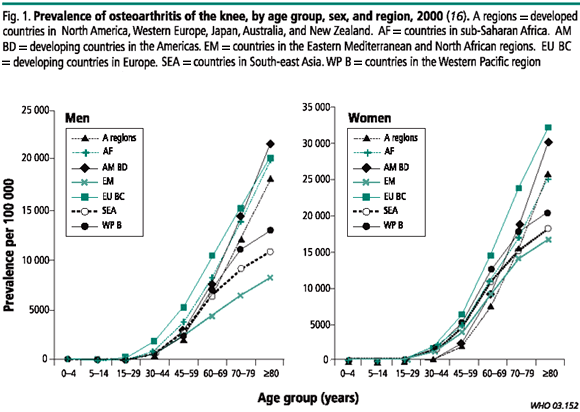
In general, osteoarthritis is more prevalent in Europe and the USA than in other parts of the world. African-American women are more prone than white women to osteoarthritis of the knee (18) but not of the hip (19). Osteoarthritis of the hip occurs more often in European whites than in Jamaican blacks (20), African blacks (21), or Chinese (22).
At-risk population
Age is the strongest predictor of the development and progression of radiographic osteoarthritis. Obesity (high body mass index) is a risk factor for the development of osteoarthritis of the hand, knee (odds ratio, 8) (23), and hip and for progression in the knee and hip. Trauma and certain physically demanding activities or occupations are also risk factors for the development of osteoarthritis of the knee and hip (24). Farming presents the greatest relative risk for osteoarthritis: 4.5 for those who work in farming for 19 years and 9.3 for those who farm for >10 years (25). A negative association exists with osteoporosis and smoking (D Symmons, unpublished data, 1996). Table 1 gives the purported risk factors for osteoarthritis.

Impact
Osteoarthritis of the knee is a major cause of impaired mobility, particularly among women. Osteoarthritis was estimated to be the eighth leading non-fatal burden of disease in the world in 1990, accounting for 2.8% of total years of living with disability, around the same percentage as schizophrenia and congenital anomalies (13). It was the sixth leading cause of years of living with disability at the global level, accounting for 3% of the total global years of living with disability (16). Its impact can be described by health state descriptions developed as part of the global burden of disease 2000 project (Table 2).
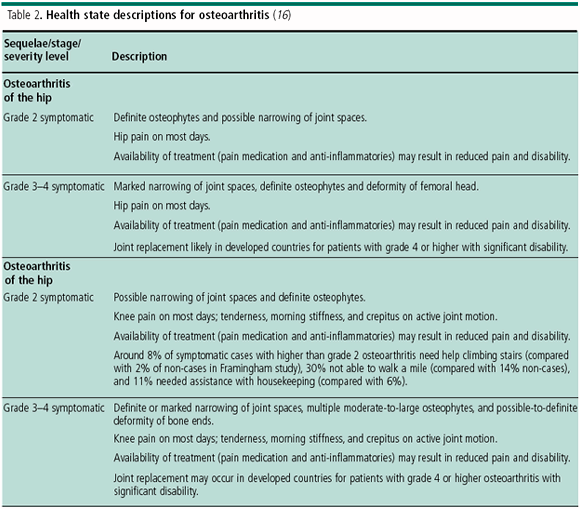
Time trends
As the incidence and prevalence of osteoarthritis rise with increasing age, extended life expectancy will result in greater numbers of people with the condition. The burden will be the greatest in developing countries, where life expectancy is increasing and access to arthroplasty and joint replacement is not readily available.
Rheumatoid arthritis
Description and definitions
Rheumatoid arthritis is an inflammatory condition with widespread synovial joint involvement. It is the most common form of chronic polyarthritis, and although it is a systemic disease, it predominantly affects peripheral joints. Persistent synovitis leads to joint destruction, which results in long-term morbidity and increased mortality. Its etiology remains unknown. The established disease is distinguished from other forms of arthritis by multiple criteria; the set agreed by the American College of Rheumatology in 1987 is usually used (26).
Remission in those classified as having rheumatoid arthritis at presentation is around 1030%. Modern treatment is effective at controlling disease activity and reducing long-term disability, and early treatment aimed at controlling disease activity is the present prevention strategy.
Incidence and prevalence
The incidence and prevalence of rheumatoid arthritis generally rise with increasing age until about age 70 years, when they start to decline (27). Around twice as many women as men are affected. The incidence of rheumatoid arthritis in populations of northern European origin is 20300 per 100 000 per year (28) and that of juvenile rheumatoid arthritis is 2050 per 100 000 per year (29).
Data on the prevalence of rheumatoid arthritis derive largely from recently reviewed studies in the USA and Europe (12, 28). The prevalence of rheumatoid arthritis in most industrialized countries varies between 0.3% and 1%; in developing countries it lies at the lower end of this range. Few or no cases have been found in African surveys (12). A link to urban living may exist, as a study in Soweto showed a prevalence of rheumatoid arthritis among black people living in urban areas equivalent to that in white Europeans (21), while the prevalence among black people who live in rural areas is much lower (12). The prevalence in native American groups can be considerably higher (30). Fig. 2 shows estimates of the prevalence of rheumatoid arthritis (29).
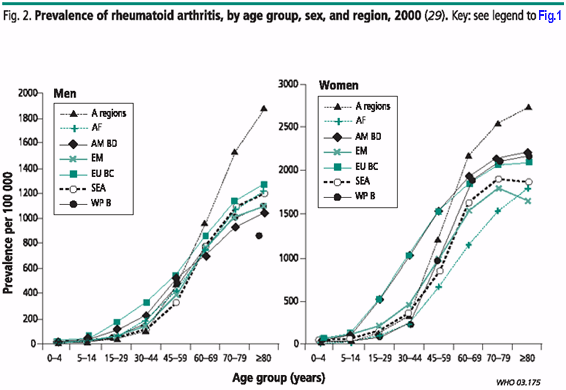
At-risk population
Rheumatoid arthritis tends to run in families, and the genetic contribution to susceptibility has been estimated at 60% (31). A shared epitope of various human leukocyte antigen-DRB1 alleles is associated with rheumatoid arthritis and probably plays a greater role in determining severity than susceptibility to rheumatoid arthritis. The prevalence of the shared epitope varies considerably between populations, which may, in part, explain the different patterns of rheumatoid arthritis seen in different countries.
Little is known about the environmental triggers for rheumatoid arthritis. Complex interactions exist between the female sex hormones and rheumatoid arthritis. Smoking and obesity are also risk factors for rheumatoid arthritis (32).
Baseline predictors of future radiological change in patients with early rheumatoid arthritis that have been identified in various cohorts include older age, female sex, longer disease duration at presentation, presence of rheumatoid factor, and presence of increased tenderness and inflammation (33).
Impact
Rheumatoid arthritis is a more disabling disease (although not necessarily more painful) than lower limb osteoarthritis, with two-thirds of patients having mild-to-moderate disability and less than 10% having severe disability (34). Disability starts early in the course of the disease and rises in a linear fashion (35). Within 10 years of disease onset, at least 50% of patients in developed countries are unable to hold down a full-time job (36). Those whose disease starts early (before the age of 45 years) are more likely to become severely disabled than those whose disease starts at an older age (>70 years).
No cure exists for rheumatoid arthritis, but disease activity and long-term disability can be improved with disease modifying therapies. In addition to drug treatment, orthopaedic surgery offers great relief, particularly to those in the second and third decade of disease who have been severely disabled. Physiotherapy and adaptations to the home may also reduce disability. With appropriate health care infrastructure and optimal application of current management strategies (drug therapy and surgery), the burden of disability from rheumatoid arthritis might be further reduced by 25% in developed countries.
Rheumatoid arthritis is associated with a reduced life expectancy, particularly in patients with more severe forms of the disease. Some evidence shows that mortality among community-based patients with rheumatoid arthritis in developing countries is also very high (37).
Time trends
Changes in the incidence and prevalence of rheumatoid arthritis are difficult to predict. Recent studies indicate a future decline in its incidence, particularly among women (38). On the other hand, the incidence is expected to increase over the next 10 years in Europe because of the increasing proportion of older people. The net result, however, is unpredictable, so prospective figures should be gathered in specific studies.
Osteoporosis and low trauma fractures
Description and definitions
Osteoporosis is characterized by a low bone mass and a microarchitectural deterioration of bone tissue, with a consequent increase in bone fragility and susceptibility to fracture. In 1994, a WHO expert panel operationalized this concept by defining diagnostic criteria for osteoporosis on the basis of measurement of bone mineral density (39) and relating it to the mean bone mineral density of young adult women (T-score):
Osteoporosis: bone mineral density more than 2.5 standard deviations below the mean bone mineral density of young adult women (bone mineral density T-score <2.5).
Osteopenia (low bone mass): bone mineral density value between 1 and 2.5 standard deviations below the mean bone mineral density of young adult women (2.5 < bone mineral density T-score < 1).
Clinically, osteoporosis is recognized by the occurrence of characteristic fractures after low-energy trauma, the best documented of these being fractures of the hip, vertebrae, and distal forearm.
Incidence and prevalence
Based on the operational definitions above and bone mineral density measures, 54% of postmenopausal white women in northern parts of the USA are estimated to have osteopenia and a further 30% to have osteoporosis in at least one skeletal site. In the United Kingdom, around 23% of women aged >50 years are estimated to have osteoporosis as defined by WHO. The general prevalence of osteoporosis rises from 5% among women aged 50 years to 50% at 85 years of age; among men, the comparable figures are 2.4% and 20% (40).
The incidence of osteoporosis is best measured indirectly, as the incidence of fractures attributed to the condition (Fig. 3). Prevalence is best measured by the frequency of reduced bone mineral density or numbers of those with vertebral deformity. The lifetime risk or the 10 year probability of fracture can also be considered (39, 42). The lifetime risk of fragility fractures at 50 years of age is considerable (Table 3). Notably, more than half of women aged 50 years will experience a fracture in their lifetime, and the 10-year probability of fracture increases dramatically with age in women.
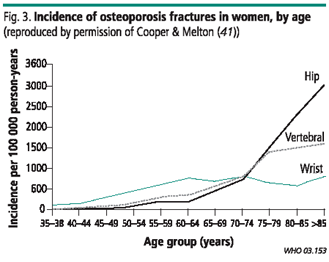
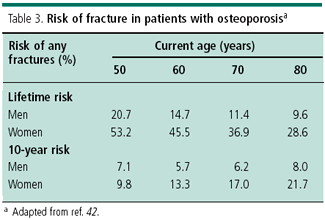
Hip fracture
In western populations, the incidence of hip fractures increases exponentially with age, with rates of 2 per100 000 person-years in women aged <35 years rising to 3032 per 100 000 person-years in women aged >85 years; respective rates in men are 4 and 1909 (41). Worldwide, 1.66 million hip fractures were estimated to have occurred in 1990: about 1.19 million in women and 463 000 in men. Fracture rates vary in different countries, the highest rates are seen in North America and Europe, particularly Scandinavia (4345). The risk of osteoporotic fractures is lower in Africa and Asia, but worldwide projections suggest that it will increase markedly in the future (39, 46, 47).
Vertebral fracture
The incidence and prevalence of radiological findings increase with age. One in eight men and women aged >50 years in Europe have vertebral deformity. The rates vary between populations, with a threefold variation across Europe and up to twofold variations within European countries in the European Vertebral Osteoporosis Study (48). Vertebral deformities in younger men may represent developmental changes rather than fractures.
Only a third of vertebral fractures present clinically. A prospective radiological study in Europe of men and women aged 5079 years found an age-adjusted incidence of vertebral deformities of 1% per year among women and 0.6% per year among men (49). Most vertebral fractures are the result of compressive loading associated with activities, such as lifting or changing positions, and are discovered only incidentally. Only a third of new vertebral fractures relate to falls.
Distal forearm fracture
Most distal forearm fractures occur in women (age-adjusted female:male ratio = 4:1). A rapid rise in incidence is noted after the menopause, the incidence then plateaus at age 65 years, but, overall, around 50% of forearm fractures occur in women aged >65 years. The incidence in men changes little between the ages of 20 and 80 years. A multicentre study in the United Kingdom found annual incidences of 9 and 37 per 10 000 men and women aged over 35 years, respectively (50).
Other fractures
Most fractures in people aged >50 years are the result of osteoporosis. The incidences of proximal humeral, pelvic, and proximal tibial fractures also rise steeply with age and are higher in women than in men. About 80% of proximal humeral fractures occur in people aged >35 years, with three-quarters occurring in women. Similar patterns have been observed for fractures of the distal femur, rib, clavicle, and scapula.
At-risk population
Apart from age and being female, the major determinants of fracture are falling, low bone mass, and previous low trauma fracture. Some risk factors identify those more likely to fall (Box 1) and those who may have osteoporosis or are at risk of fracture (Box 2).
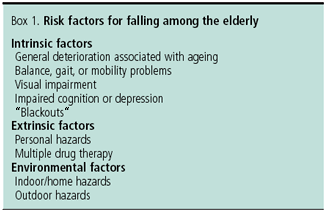
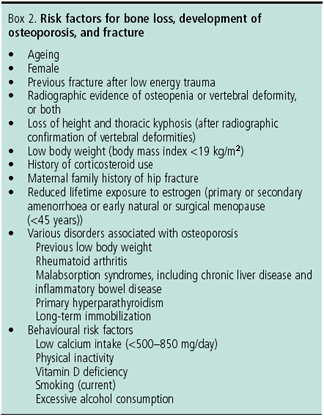
Bone density has the strongest relation to fracture, but many fractures also occur among women without osteoporosis. Combinations of risk factors are being used to predict 10-year probability of fracture.
Impact
Hip fracture results in pain, loss of mobility, and excess mortality. Nearly all patients are hospitalized, and most undergo surgical repair of the fracture or replacement of the joint. At one year, hip fracture is associated with 20% mortality within the first year after fracture and 50% loss of function; only 30% of patients regain function (51). Many patients lose their independence and need long-term care. In urbanized countries, mortality from hip fracture is high in the first year perhaps up to 25% in women and 35% in men. Comorbidity is an important contributory factor to hip fractures and is a determinant of outcome (52).
Acute vertebral fracture affects quality of life by limiting activities and restricting participation. Up to a fifth of patients are hospitalized, and some will need subsequent long-term care. Pain and disability worsen with each new vertebral fracture, with an increasing total number of vertebral fractures and worsening of spinal deformity. Vertebral fractures are also associated with an increased mortality of about 5% over the five-year period after fracture.
Fracture of the distal forearm results in hospitalization rates of 23% among men and 19% among women (50). Only 50% of patients have a good functional outcome at six months (53).
Time trends
The number of hip fractures is increasing throughout the world, and the projected number for 2050 is 6.3 million worldwide (Fig. 4). The increase will affect Asian populations in particular; more than half of all hip fractures worldwide are estimated to occur in Asia by 2050 (46).
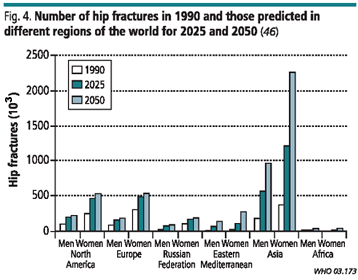
Low back pain
Description and definitions
Low back pain is a major health and socioeconomic problem in western countries. It usually is defined as pain localized below the line of the twelfth rib and above the inferior gluteal folds (54), with or without leg pain; and it can be classified as "specific" (suspected pathological cause) or "non-specific" (about 90% of cases). Back pain is usually defined as acute if it lasts less than six weeks; subacute if between six weeks and three months; and chronic when it lasts more than three months (55). Frequent episodes are described as recurrent back pain.
Most episodes of low back pain settle after a couple of weeks, but many have a recurrent course, with further acute episodes affecting 2044% of patients within one year in the working population and lifetime recurrences of up to 85% (56, 57). Frequently, low back pain never fully resolves, and patients experience exacerbations of chronic low back pain.
Incidence and prevalence
Back pain is very common, but its prevalence varies according to the definitions used and the population studied.
A large study from the Netherlands reported an incidence of 28.0 episodes per 1 000 persons per year and for low back pain with sciatica an incidence of 11.6 per 1000 persons per year. Low back pain affects men a little more than women and is most frequent in the working population, with the highest incidence seen in those aged 2564 years (58). New episodes are twice as common in people with a history of low back pain. Lifetime prevalence is 5884% and the point prevalence (proportion of population studied that are suffering back pain at a particular point of time) is 433%. Fig. 5 shows estimates for low back pain prevalence.

At-risk population
The occurrence of low back pain is associated with age, physical fitness, smoking, excess body weight, and strength of back and abdominal muscles. Psychological factors associated with occurrence of back pain are anxiety, depression, emotional instability, and pain behaviour (e.g. (exaggerated) outward display of pain, guarding). Occupational factors, such as heavy work, lifting, bending, twisting, pulling, and pushing, clearly play a role, as do psychological workplace variables, such as job dissatisfaction. Psychosocial aspects of health and work in combination with economic aspects seem to have more impact on work loss than physical aspects of disability and physical requirements of the job.
Impact
Back pain has a marked effect on the patient and on society because of its frequency and economic consequences.
Pain often is persistent during the episode, and many patients do not have complete resolution of their symptoms but have "flares" against a background of chronic pain. Pain is often worse with prolonged walking, standing, and sitting, which restricts mobility, as well as when travelling any distance in a vehicle. Pain may affect sleep. Episodes and fear of recurrence may affect strenuous activities and leisure pursuits. Most patients return to work within one week and 90% return within two months, but the longer a person is on sick leave the less likely he or she is to return to work. After six months off work, less than 50% of people will return to work, and after two years absence, there is little chance of the person returning, which greatly impacts on society.
Time trends
An increase in prevalence of back pain in the United Kingdom was reported between 1980 and 2000 (59), but this is believed to be related to greater awareness of minor back symptoms and willingness to report them. Such cultural changes in other parts of the world, where back pain is not considered to be a condition associated with disability by many people, could lead to an enormous increase in its burden.
Societal impact of musculoskeletal conditions
Musculoskeletal conditions have a major impact on society due to their frequency, chronicity, and resultant disability.
Work disability
Musculoskeletal complaints are a major cause of absence because of sickness in developed countries (60, 61); they are second only to respiratory disorders as a cause of short-term sickness absence (less than two weeks) (62). Musculoskeletal complaints are the most common medical causes of long-term absence, accounting for more than half of all sickness absences lasting longer than two weeks in Norway (63). Statistics on sickness absence in Norway show that of people who took sick leave for longer than four days because of musculoskeletal and connective tissue disorders, 33% had low back pain and 20% neck and shoulder disorders, but only 3% had rheumatoid arthritis.
Musculoskeletal complaints also are common reasons for people claiming disability pensions, along with mental disorders and cardiovascular disorders. In Sweden, up to 60% of people on early retirement or long-term sick leave claimed musculoskeletal problem as the reason (64). In Norway, low back disorders were the most common reason for people claiming disability pensions (65).
Utilization of health care services
Musculoskeletal complaints are the second most common reason for consulting a doctor and constitute, in most countries, up to 1020% of primary care consultations (66). In the Ontario Health Survey, musculoskeletal complaints were the reason for almost 20% of all health care utilization (7). They were the most expensive disease category in the Swedish cost of illness study, representing 22.6% of the total cost of illness; the greatest costs were indirect costs related to morbidity and disability (67). The total direct cost for use of health services that results from musculoskeletal conditions was 0.7% of the gross national product in the Netherlands, 1.0% in Canada, and 1.2% in the USA (68, 69). The indirect costs of musculoskeletal conditions (loss of productivity and wages) were much greater than the direct costs, corresponding to 2.4% and 1.3% of the gross national products of Canada and the USA, respectively.
Future trends
The impact of musculoskeletal disorders on individuals and society is expected to increase dramatically. Many of these conditions are more prevalent or have a greater impact in older patients, and the predicted ageing of the worlds population, predominantly in less-developed countries, will markedly increase the number of people affected by these conditions. In addition, changes in lifestyle factors, such as increased obesity and lack of physical activity with the urbanization and motorization of the developing world, will further increase the burden. 
Conflicts of interest: none declared.
References
1. Woolf AD, Akesson K. Understanding the burden of musculoskeletal conditions. The burden is huge and not reflected in national health priorities. BMJ 2001;322:1079-80.
2. The Consensus Document. The Bone and Joint Decade 2000-2010. Inaugural Meeting 17 and 18 April 1998. Acta Orthopaedica Scandinavica 1998;69:67-86.
3. Woolf AD. The bone and joint decade 2000-2010. Annals of Rheumatic Disease 2000;59:81-2.
4. The burden of musculoskeletal diseases at the start of the new millennium. Report of a WHO scientific group. Geneva: World Health Organization, 2003. Technical Report Series, No. 919. Forthcoming.
5. Kazis LE, Meenan RF, Anderson JJ. Pain in the rheumatic diseases. Investigation of a key health status component. Arthritis and Rheumatism 1983;26:1017-22.
6. van Baar ME, Dekker J, Lemmens JA, Oostendorp RA, Bijlsma JW. Pain and disability in patients with osteoarthritis of hip or knee: the relationship with articular, kinesiological, and psychological characteristics. Journal of Rheumatology 1998;25:125-33.
7. Badley EM, Rasooly I, Webster GK. Relative importance of musculoskeletal disorders as a cause of chronic health problems, disability, and health care utilization: findings from the 1990 Ontario Health Survey. Journal of Rheumatology 1994;21:505-14.
8. Reynolds DL, Chambers LW, Badley EM, Bennett KJ, Goldsmith CH, Jamieson E, et al. Physical disability among Canadians reporting musculoskeletal diseases. Journal of Rheumatology 1992;19:1020-30.
9. Kellgren JH, Lawrence JS. Osteoarthritis and disk degeneration in an urban population. Annals of Rheumatic Diseases 1958;17:388-97.
10. Altman R, Asch E, Bloch D, Bole G, Borenstein D, Brandt K, et al. Development of criteria for the classification and reporting of osteoarthritis. Classification of osteoarthritis of the knee. Diagnostic and Therapeutic Criteria Committee of the American Rheumatism Association. Arthritis and Rheumatism 1986;29:1039-49.
11. Mathers C, Vos T, Stevenson C. The burden of disease and injury in Australia. Canberra: Australian Institute of Health and Welfare; 1999.
12. Silman AJ, Hochberg MC. Epidemiology of the rheumatic diseases. Oxford: Oxford University Press; 1993.
13. Murray CJL, Lopez AD, editors. The global burden of disease. A comprehensive assessment of mortality and disability from diseases, injuries, and risk factors in 1990 and projected to 2020. Cambridge (MA): Harvard School of Public Health on behalf of the World Health Organization and The World Bank; 1996.
14. Valkenburg HA. Clinical versus radiological osteoarthritis in the general population. In: Peyron JG, editor. Epidemiology of osteoarthritis. Paris: Ciba-Geigy; 1980. p. 53-8.
15. Spector TD, Hart DJ, Leedham-Green M. The prevalence of knee and hand osteoarthritis (OA) in the general population using different clinical criteria: The Chingford Study. Arthritis and Rheumatism 1991;34:S171.
16. Symmons D, Mathers C, Pfleger B. Global burden of osteoarthritis in the year 2000. Geneva: World Health Organization; 2003. Available from: URL: http://www3.who.int/whosis/menu.cfm?path=evidence,burden,burden_gbd2000docs &language=english
17. Danielsson L, Lindberg H. Prevalence of coxarthrosis in an urban population during four decades. Clinical Orthopaedics and Related Research 1997;342:106-10.
18. Anderson JJ, Felson DT. Factors associated with osteoarthritis of the knee in the first national Health and Nutrition Examination Survey (HANES I). Evidence for an association with overweight, race, and physical demands of work. American Journal of Epidemiology 1988;128:179-89.
19. Tepper S, Hochberg MC. Factors associated with hip osteoarthritis: data from the First National Health and Nutrition Examination Survey (NHANES-I). American Journal of Epidemiology 1993;137:1081-8.
20. Bremner JM, Lawrence JS, Miall WE. Degenerative joint disease in a Jamaican rural population. Annals of Rheumatic Disease 1968;27:326-32.
21. Solomon L, Beighton P, Lawrence JS. Rheumatic disorders in the South African Negro. Part II. Osteo-arthrosis. South African Medical Journal 1975;49:1737-40.
22. Hoaglund FT, Yau AC, Wong WL. Osteoarthritis of the hip and other joints in southern Chinese in Hong Kong. Journal of Bone and Joint Surgery. American volume 1973;55:545-57.
23. Davis MA, Neuhaus JM, Ettinger WH, Mueller WH. Body fat distribution and osteoarthritis. American Journal of Epidemiology 1990;132:701-7.
24. Petersson IF, Jacobsson LT. Osteoarthritis of the peripheral joints. Bailliere's best practice & research. Clinical rheumatology 2002;16:741-60.
25. Croft P, Coggon D, Cruddas M, Cooper C. Osteoarthritis of the hip: an occupational disease in farmers. BMJ 1992;304:1269-72.
26. Arnett FC, Edworthy SM, Bloch DA, McShane DJ, Fries JF, Cooper NS, et al. The American Rheumatism Association 1987 revised criteria for the classification of rheumatoid arthritis. Arthritis and Rheumatism 1988;31:315-24.
27. Linos A, Worthington JW, OFallon WM, Kurland LT. The epidemiology of rheumatoid arthritis in Rochester, Minnesota: a study of incidence, prevalence, and mortality. American Journal of Epidemiology 1980;111:87-98.
28. Abdel-Nasser AM, Rasker JJ, Valkenburg HA. Epidemiological and clinical aspects relating to the variability of rheumatoid arthritis. Seminars in Arthritis and Rheumatism 1997;27:123-40.
29. Symmons D, Mathers C, Pfleger B. The global burden of rheumatoid arthritis in the year 2000. Geneva: World Health Organization; 2003. Available at: URL: http://www3.who.int/whosis/menu.cfm?path=evidence,burden, burden_gbd2000docs&language=english.
30. Del Puente A, Knowler WC, Pettitt DJ, Bennett PH. High incidence and prevalence of rheumatoid arthritis in Pima Indians. American Journal of Epidemiology 1989;129:1170-8.
31. MacGregor AJ, Snieder H, Rigby AS, Koskenvuo M, Kaprio J, Aho K, et al. Characterizing the quantitative genetic contribution to rheumatoid arthritis using data from twins. Arthritis and Rheumatism 2000;43:30-7.
32. Symmons D, Harrison B. Early inflammatory polyarthritis: results from the Norfolk arthritis register with a review of the literature. I. Risk factors for the development of inflammatory polyarthritis and rheumatoid arthritis. Rheumatology (Oxford) 2000;39:835-43.
33. Ollier WE, Harrison B, Symmons D. What is the natural history of rheumatoid arthritis? Baillieres best practice & research. Clinical rheumatology 2001;15:27-48.
34. Hakala M, Nieminen P, Koivisto O. More evidence from a community based series of better outcome in rheumatoid arthritis. Data on the effect of multidisciplinary care on the retention of functional ability. Journal of Rheumatology 1994;21:1432-7.
35. Hochberg MC, Chang RW, Dwosh I, Lindsey S, Pincus T, Wolfe F. The American College of Rheumatology 1991 revised criteria for the classification of global functional status in rheumatoid arthritis. Arthritis and Rheumatism 1992;35:498-502.
36. Brooks PM. MJA Practice Essentials Rheumatology. Sydney: Australasian Medical Publishing Company Limited; 1997.
37. Darmawan J, Muirden KD, Valkenburg HA, Wigley RD. The epidemiology of rheumatoid arthritis in Indonesia. British Journal of Rheumatology 1993;32:537-40.
38. Spector TD, Hart DJ, Powell RJ. Prevalence of rheumatoid arthritis and rheumatoid factor in women: evidence for a secular decline. Annals of Rheumatic Disease 1993;52:254-7.
39. Assessment of fracture risk and its application to screening for postmenopausal osteoporosis. Geneva: World Health Organization; 1994. Technical Report Series, No. 843.
40. Kanis JA, Johnell O, Oden A, Jonsson B, De Laet C, Dawson A. Risk of hip fracture according to the World Health Organization criteria for osteopenia and osteoporosis. Bone 2000;27:585-90.
41. Cooper C, Melton LJ III. Epidemiology of osteoporosis. Trends in Endocrinology and Metabolism 1992;314:224-9.
42. van Staa TP, Dennison EM, Leufkens HG, Cooper C. Epidemiology of fractures in England and Wales. Bone 2001;29:517-22.
43. Bacon WE, Maggi S, Looker A, Harris T, Nair CR, Giaconi J, et al. International comparison of hip fracture rates in 1988-89. Osteoporosis International 1996;6:69-75.
44. Elffors I, Allander E, Kanis JA, Gullberg B, Johnell O, Dequeker J, et al. The variable incidence of hip fracture in southern Europe: the MEDOS Study. Osteoporosis International 1994;4:253-63.
45. Johnell O, Gullberg B, Allander E, Kanis JA. The apparent incidence of hip fracture in Europe: a study of national register sources. MEDOS Study Group. Osteoporosis International 1992;2:298-302.
46. Cooper C, Campion G, Melton LJ III. Hip fractures in the elderly: a world-wide projection. Osteoporosis International 1992;2:285-9.
47. Gullberg B, Johnell O, Kanis JA. World-wide projections for hip fracture. Osteoporosis International 1997;7:407-13.
48. O'Neill TW, Felsenberg D, Varlow J, Cooper C, Kanis JA, Silman AJ. The prevalence of vertebral deformity in European men and women: the European Vertebral Osteoporosis Study. Journal of Bone and Mineral Research 1996;11:1010-8.
49. The European Prospective Osteoporosis Study Group. Incidence of vertebral fractures in Europe: results from the European prospective osteoporosis study (EPOS). Journal of Bone and Mineral Research 2002;17:716-24.
50. O'Neill TW, Cooper C, Finn JD, Lunt M, Purdie D, Reid DM, et al. Incidence of distal forearm fracture in British men and women. Osteoporosis International 2001;12:555-8.
51. Sernbo I, Johnell O. Consequences of a hip fracture: a prospective study over 1 year. Osteoporosis International 1993;3:148-53.
52. Cooper C. The crippling consequences of fractures and their impact on quality of life. American Journal of Medicine 1997;103:12S-17S.
53. Kaukonen JP, Karaharju EO, Porras M, Luthje P, Jakobsson A. Functional recovery after fractures of the distal forearm. Analysis of radiographic and other factors affecting the outcome. Annales Chirurgiae et Gynaecologiae 1988;77:27-31.
54. Anderson JA. Epidemiological aspects of back pain. Journal of the Society of Occupational Medicine 1986;36:90-4.
55. Frymoyer JW. Back pain and sciatica. New England Journal of Medicine 1988;318:291-300.
56. Felson DT. Does excess weight cause osteoarthritis and, if so, why? Annals of Rheumatic Disease 1996;55:668-70.
57. Andersson GB. Epidemiological features of chronic low-back pain. Lancet 1999;354:581-5.
58. Van den Velden J, De Bakker DH, Claessens AAMC, Schellevis FG. [A national study of illness encountered in general practitioners' surgeries. Basic report: morbidity in general practice] Utrecht: NIVEL; 1991 In Dutch.
59. Palmer KT, Walsh K, Bendall H, Cooper C, Coggon D. Back pain in Britain: comparison of two prevalence surveys at an interval of 10 years. BMJ 2000;320:1577-8.
60. Tellnes G, Bjerkedal T. Epidemiology of sickness certification a methodological approach based on a study from Buskerud County in Norway. Scandinavian Journal of Social Medicine 1989;17:245-51.
61. Szubert Z, Sobala W, Zycinska Z. [The effect of system restructuring on absenteeism due to sickness in the work place. I. Sickness absenteeism during the period 1989-1994.] Medycyna Pracy 1997;48:543-51. In Polish.
62. Stansfeld SA, North FM, White I, Marmot MG. Work characteristics and psychiatric disorder in civil servants in London. Journal of Epidemiology and Community Health 1995;49:48-53.
63. Brage S, Nygard JF, Tellnes G. The gender gap in musculoskeletal-related long-term sickness absence in Norway. Scandinavian Journal of Social Medicine 1998;26:34-43.
64. National Board on Health and Welfare. Yearbook of Health and Medical Care, 2001. Stockholm: Socialstyrelsen, 2001. Available from: URL: http://www.sos.se
65. National Insurance Administration. Oslo: Norway; 1998 available from: URL: http://www.trygdeetaten.no/
66. Rasker JJ. Rheumatology in general practice. British Journal of Rheumatology 1995;34:494-7.
67. Jacobson L, Lindgren B. [What are the costs of illness?] Stockholm: Socialstyrelsen (National Board of Health and Welfare); 1996. In Swedish.
68. Coyte PC, Asche CV, Croxford R, Chan B. The economic cost of musculoskeletal disorders in Canada. Arthritis Care and Research 1998;11:315-25.
69. Yelin E, Callahan LF. The economic cost and social and psychological impact of musculoskeletal conditions. National Arthritis Data Work Groups. Arthritis Rheumatism 1995;38:1351-62.
1 Correspondence should be addressed to this author.
